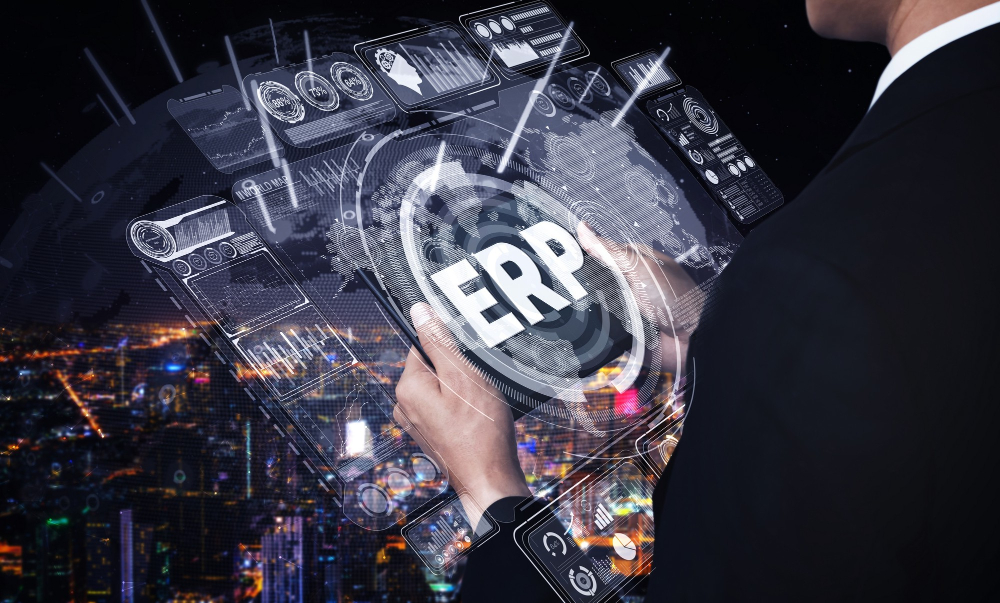
As we step into 2024, the landscape of Enterprise Resource Planning (ERP) systems continues to evolve, driven by rapid technological advancements and changing business needs. This evolution is not just about enhancing efficiency but also about creating smarter, more agile systems that can adapt to the dynamic nature of the modern business environment. Let’s explore some of the key trends shaping the future of ERP systems, offering a glimpse into what businesses can expect and how they can prepare.
AI-Driven ERP: The Intelligence Revolution
Artificial Intelligence (AI) has become a cornerstone of modern ERP systems, enabling smarter decision-making and operational efficiency. AI-driven ERP systems leverage machine learning algorithms to analyze vast amounts of data, identify patterns, and provide actionable insights. This intelligence revolution is helping businesses automate routine tasks, optimize processes, and make informed strategic decisions. For example, AI can predict inventory shortages, optimize supply chains, and even anticipate customer demand.
Machine Learning Integration: Enhancing Predictive Capabilities
Machine learning, a subset of AI, is particularly influential in enhancing the predictive capabilities of ERP systems. By learning from historical data, machine learning models can forecast future trends, such as sales volumes, market demand, and even potential equipment failures. This predictive power enables businesses to proactively address issues before they arise, reducing downtime and improving overall efficiency.
Predictive Analytics: From Reactive to Proactive Management
Predictive analytics is transforming ERP systems from reactive tools into proactive management systems. By leveraging data mining, statistical algorithms, and machine learning, predictive analytics provides businesses with the ability to anticipate outcomes and trends. This capability is crucial for strategic planning, allowing companies to align their operations with market trends, customer preferences, and potential risks.
Cloud-Native Architecture: Flexibility and Scalability
The shift towards cloud-native architecture in ERP systems is driven by the need for greater flexibility and scalability. Cloud-native ERP solutions offer businesses the ability to scale resources up or down based on demand, reduce infrastructure costs, and enhance accessibility. This architecture also supports seamless integration with other cloud-based applications, enabling businesses to create a more cohesive and efficient technology ecosystem.
Low-Code/No-Code Customization: Democratizing ERP Development
The emergence of low-code and no-code platforms is democratizing ERP customization, allowing non-technical users to modify and extend ERP systems without extensive coding knowledge. This trend is particularly beneficial for businesses that need to adapt their ERP systems quickly to changing requirements. With low-code/no-code tools, users can create custom workflows, dashboards, and applications, enhancing the system’s functionality and aligning it more closely with specific business needs.
IoT Connectivity: Extending the Digital Ecosystem
The Internet of Things (IoT) is expanding the capabilities of ERP systems by integrating physical devices and sensors into the digital ecosystem. IoT connectivity allows ERP systems to collect real-time data from manufacturing equipment, vehicles, and other assets, providing valuable insights into operational efficiency, maintenance needs, and more. This real-time data can be used to optimize processes, reduce costs, and improve decision-making.
Blockchain Integration: Enhancing Security and Transparency
Blockchain technology is being integrated into ERP systems to enhance security, transparency, and traceability. Blockchain’s decentralized ledger technology provides a secure and immutable record of transactions, making it ideal for industries that require stringent data integrity and traceability, such as supply chain management, finance, and healthcare. By integrating blockchain, ERP systems can provide a secure platform for transactions, reduce fraud, and improve compliance.
Digital Twin Technology: Bridging the Physical and Digital Worlds
Digital twin technology, which creates a virtual replica of physical assets or systems, is being integrated into ERP systems to provide real-time monitoring and analytics. This technology enables businesses to simulate and analyze the performance of their assets under various conditions, allowing for predictive maintenance, optimized operations, and improved decision-making. Digital twins can be used in manufacturing, logistics, and facility management, among other areas.
Hyper-Automation: Streamlining Processes End-to-End
Hyper-automation, the use of advanced technologies like AI, machine learning, and robotic process automation (RPA) to automate complex business processes, is a growing trend in ERP systems. This approach goes beyond traditional automation by integrating these technologies to create end-to-end automated workflows. Hyper-automation helps businesses increase efficiency, reduce costs, and minimize human error, while also freeing up employees to focus on higher-value tasks.
Edge Computing in ERP: Bringing Intelligence Closer to the Source
Edge computing is an emerging trend in ERP systems, especially for industries that require real-time data processing and low latency. By processing data closer to the source—such as on manufacturing floors, in warehouses, or in vehicles—edge computing reduces the need to send data back to centralized servers, improving response times and efficiency. This approach is particularly valuable for applications like predictive maintenance, quality control, and inventory management.
Natural Language Processing (NLP): Simplifying User Interaction
Natural Language Processing (NLP) is enhancing user interaction with ERP systems by enabling more intuitive, conversational interfaces. With NLP, users can interact with ERP systems using natural language commands, making it easier to access information, generate reports, and perform tasks without the need for complex queries or commands. This user-friendly interface is helping businesses improve user adoption and reduce training costs.
Get in Touch
We know what NetSuite can do and how it can help you. Schedule your free NetSuite assessment today
Augmented Reality (AR) in ERP: Enhancing Visualization and Training
Augmented Reality (AR) is being integrated into ERP systems to enhance visualization and training. AR can overlay digital information onto the physical world, providing real-time guidance and insights for tasks such as equipment maintenance, assembly, and quality inspection. In addition, AR can be used for training purposes, allowing employees to practice tasks in a virtual environment before performing them in the real world. This technology is particularly valuable in industries such as manufacturing, construction, and healthcare.
Continuous Intelligence: Real-Time Analytics and Decision Making
Continuous intelligence, the integration of real-time analytics into business operations, is a key trend in ERP systems. By continuously analyzing data from various sources, ERP systems can provide insights and recommendations in real-time, enabling businesses to respond quickly to changing conditions. This capability is crucial for dynamic environments, such as supply chain management, where timely decision-making can have a significant impact on efficiency and profitability.
Autonomous ERP: The Future of Self-Managing Systems
The concept of autonomous ERP systems is becoming a reality as AI and machine learning technologies advance. Autonomous ERP systems can self-manage and self-optimize by learning from data and adapting to changes in the business environment. These systems can automate routine tasks, make decisions, and even predict future trends without human intervention. This level of autonomy can significantly reduce the burden on IT teams and improve overall system efficiency.
Microservices Architecture: Modular and Agile ERP Systems
Microservices architecture, which breaks down ERP systems into smaller, independent services, is gaining traction as businesses seek more modular and agile solutions. This architecture allows businesses to update or replace individual services without affecting the entire system, enabling faster development and deployment cycles. Microservices also enhance scalability, as each service can be scaled independently based on demand.
API-First Approach: Enabling Seamless Integration
An API-first approach is becoming the norm in ERP systems, enabling seamless integration with other applications and services. By prioritizing the development of APIs, ERP vendors ensure that their systems can easily connect with a wide range of third-party solutions, from CRM and HRM systems to e-commerce platforms and IoT devices. This approach enhances the flexibility and interoperability of ERP systems, allowing businesses to create a more cohesive technology ecosystem.
Quantum Computing in ERP: Exploring New Frontiers
While still in its early stages, quantum computing holds significant potential for the future of ERP systems. Quantum computing can process complex calculations at unprecedented speeds, making it ideal for solving optimization problems, such as supply chain logistics, financial modeling, and risk assessment. As quantum computing technology matures, it could revolutionize the capabilities of ERP systems, enabling businesses to tackle challenges that are currently beyond the reach of classical computing.
Cybersecurity Advancements: Protecting Sensitive Data
With the increasing complexity and connectivity of ERP systems, cybersecurity has become a top priority. Advanced cybersecurity measures, such as encryption, multi-factor authentication, and behavioral analytics, are being integrated into ERP systems to protect sensitive data from threats such as hacking, data breaches, and ransomware attacks. These measures are crucial for maintaining the integrity and confidentiality of business data, especially as regulatory requirements become more stringent.
Sustainability Tracking: Aligning with Environmental Goals
As businesses place greater emphasis on sustainability, ERP systems are evolving to support environmental tracking and reporting. These systems can monitor key sustainability metrics, such as energy consumption, carbon emissions, and waste generation, helping businesses track their progress towards environmental goals. By integrating sustainability tracking into ERP systems, businesses can make more informed decisions that align with their corporate social responsibility (CSR) initiatives.
Conversational ERP Interfaces: Enhancing User Experience
Conversational interfaces, powered by AI and NLP, are transforming the way users interact with ERP systems. These interfaces allow users to engage with the system through voice commands or chatbots, making it easier to access information and perform tasks. Conversational ERP interfaces improve user experience by providing a more intuitive and accessible way to interact with the system, reducing the learning curve and increasing productivity.
Preparing for the Future: Strategic Considerations
As these trends continue to shape the future of ERP systems, businesses need to strategically plan their adoption to maximize benefits and minimize disruption. Here are some key considerations:
- Assess Current Systems: Evaluate your existing ERP system to identify gaps and areas for improvement. Consider how the latest technologies can address these gaps and align with your business goals.
- Prioritize Integration: Focus on integrating new technologies with your existing systems and processes. An API-first approach can facilitate seamless integration, allowing you to leverage the full potential of new tools.
- Invest in Training: Ensure that your team is equipped with the skills and knowledge needed to use new ERP features effectively. Invest in training and support to enhance user adoption and minimize resistance.
- Plan for Scalability: As your business grows, your ERP system should be able to scale with it. Choose solutions that offer flexibility and scalability, whether through cloud-native architecture, microservices, or other approaches.
- Focus on Security: With the increasing complexity of ERP systems, cybersecurity must be a top priority. Implement robust security measures to protect sensitive data and comply with regulatory requirements.
- Embrace Sustainability: Consider how your ERP system can support your sustainability goals. Track key environmental metrics and use the data to make informed decisions that align with your CSR initiatives.
- Stay Agile: The technology landscape is constantly evolving, and your ERP system should be able to adapt to new trends and challenges. Stay agile and be prepared to update or modify your system as needed.
Conclusion
The future of ERP systems is shaped by a range of emerging technologies and trends that promise to enhance efficiency, agility, and intelligence. From AI-driven analytics and machine learning integration to IoT connectivity and blockchain, these advancements are transforming ERP systems into more powerful and versatile tools. As businesses navigate this evolving landscape, strategic planning and a focus on integration, security, and scalability will be key to unlocking the full potential of these innovations. By staying informed and proactive, businesses can position themselves at the forefront of this exciting transformation, ready to capitalize on the opportunities that the future holds.
FAQs:
Key trends include AI-driven ERP, machine learning integration, predictive analytics, cloud-native architecture, low-code/no-code customization, IoT connectivity, blockchain integration, digital twin technology, hyper-automation, edge computing, NLP, AR, continuous intelligence, autonomous ERP, microservices architecture, API-first approach, quantum computing, cybersecurity advancements, sustainability tracking, and conversational ERP interfaces.
AI enables smarter decision-making and operational efficiency by analyzing vast amounts of data, identifying patterns, and providing actionable insights. It helps automate routine tasks, optimize processes, and make informed strategic decisions, such as predicting inventory shortages and optimizing supply chains.
Machine learning enhances predictive capabilities by learning from historical data to forecast trends like sales volumes and market demand. This helps businesses proactively address issues, reducing downtime and improving efficiency.
Predictive analytics transforms ERP systems from reactive tools to proactive management systems. It allows businesses to anticipate outcomes and trends, aligning operations with market trends, customer preferences, and potential risks.
Cloud-native architecture provides greater flexibility and scalability, reducing infrastructure costs and enhancing accessibility. It supports seamless integration with other cloud-based applications, creating a cohesive and efficient technology ecosystem.
Low-code/no-code platforms democratize ERP customization by allowing non-technical users to modify and extend ERP systems without extensive coding knowledge. This enables businesses to quickly adapt their systems to changing requirements and create custom workflows, dashboards, and applications.
IoT connectivity integrates physical devices and sensors into the digital ecosystem, providing real-time data on operational efficiency, maintenance needs, and more. This data helps optimize processes, reduce costs, and improve decision-making.
Blockchain provides a secure and immutable record of transactions, enhancing security, transparency, and traceability. It is ideal for industries requiring stringent data integrity, such as supply chain management, finance, and healthcare.
Hyper-automation uses advanced technologies like AI, machine learning, and robotic process automation to automate complex business processes. It increases efficiency, reduces costs, minimizes human error, and frees up employees for higher-value tasks.
Businesses should assess their current systems, prioritize integration, invest in training, plan for scalability, focus on security, embrace sustainability, and stay agile to adapt to new trends and challenges. Strategic planning and proactive management are key to unlocking the full potential of future ERP innovations.








